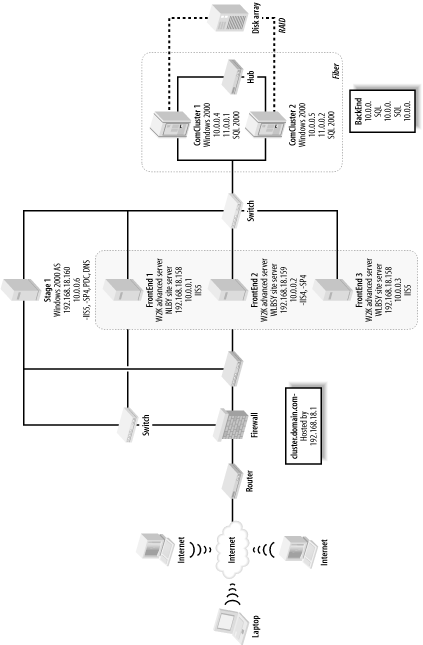Hack 47 Implement Windows 2000 Network Load Balancing
| < Day Day Up > |
| If you need network load balancing software on your network, why not try the NLB component that comes with Windows 2000 Advanced Server? Installing Windows Network Load Balancing (NLB) is often a terrific idea. Most network load balancing hardware devices today cost over $20,000. Thus, if your web application or content site is not necessarily going to support traffic as heavy as http://www.msn.com, NLB is a great choice. However, this mighty piece of web-balancing code from Microsoft has a few implementation gotchas that can crop up at any minute. Let's quickly review the basics, which most you probably already know. You can run NLB only on Windows 2000 Advanced Server, Windows 2000 Datacenter Server, or any edition of Windows Server 2003. NLB also has a role in Microsoft Application Center, but the concept is the same. The following tips provide successful techniques to use with NLB. Two NIC EnvironmentPlan on a two-NIC environment. For instance, identify a private network for Windows network activity, such as domain-level functions, file sharing, or name resolution. Identify the second NIC as the public- or client- facing connection. While NLB supports both unicast and multicast routing, using two NICS lets you avoid the complexities of using multicast mode. However, if you do want to use multicast mode with NLB, then either use a VLAN for all NLB NIC connections (which prevents saturating your Layer 2 network switches) or use a hub (that's right, a nonswitched hub) for all NLB NICs and allow the hub to make one connection to the Layer 2 switch front-ending your web farm. For security reasons, ensure also that the NLB NIC is stripped of all services, such as File and Print Sharing and the Microsoft network client. However, if you want to go home from work early, don't even try to run NLB on one NIC using multicast mode. The underlying technical challenge for Layer 2 switches and NLB is that the NLB-based NICs create a dummy MAC address and provide it to the MAC address table of the switch to which they are connected. NLB has to receive all traffic addresses to the NLB cluster for the software algorithm in use to make a decision on which node to send the traffic to. Some Layer 2 switches get confused at the same MAC address coming through different ports, and this can create the dreaded broadcast storm . Sample EnvironmentThe scenario shown in Figure 4-3 illustrates Microsoft Network Load Balancing in use in a standard Microsoft n- tier highly available Internet configuration. The three front-end IIS web servers (the dark shaded area in Figure 4-3) all are running Windows 2000 Advanced Server and illustrate the redundancy and load balancing archived with an NLB solution. Each web server has its own internal or primary IP address of the form 10.0.0.x, which is a nonroutable address for security and management purposes, while the clustered or shared IP addresses are of the form 192.168.18.x. The firewall in front of the web farm is configured to perform a network translation of the actual hosted web site's DNS name and IP address to the listening IP address 192.168.18.158 of NLB. In this case, equal load balancing is used, such that each web server will carry 33% of the load so that NLB will load-balance traffic based on an equal distribution of the incoming traffic. If one server goes down, the load will be distributed to the remaining two servers. Figure 4-3. Using Network Load Balancing in an n-tier configuration Other Microsoft high-availability technologies can also be seen in this examplefor example, the use of a SQL Server cluster (the light-shaded area in Figure 4-3) providing backend database services for this solution. This illustrates the relationship between Microsoft Clustering Services (MSCS) and Microsoft Network Load Balancing (NLB): generally , they secure different tiers of highly available Microsoft solutions. In this case, NLB is used for the web tier, while clustering is used for the database tier. These tips and the corresponding scenario should save you considerable time when implementing NLB web clusters using Windows 2000/2003. The main thing to remember, though, is to never fall for the one NIC multicast option when using Microsoft Network Load Balancing. |
| < Day Day Up > |